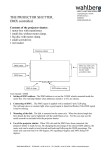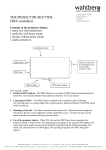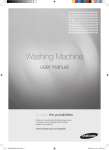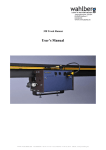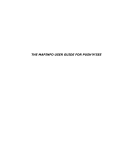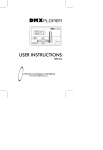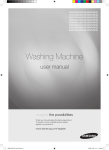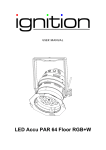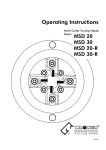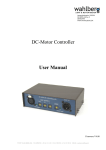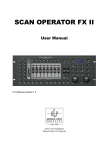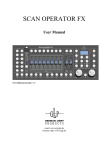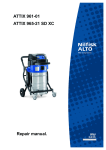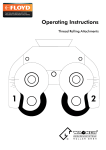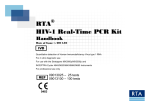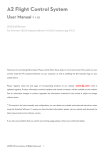Download - Wahlberg Light & Motion Design
Transcript
Jægergårdsgade 152/05A DK-8000 Aarhus C DENMARK WWW.WAHLBERG.DK Front page AC Motor Controller 2200W User Manual WWW.WAHLBERG.DK · TELEPHONE +45 86 18 14 20 · CELL PHONE +45 40 52 20 88 · EMAIL: [email protected] April 2011 AC Motor Controller features The AC Motor Controller is an advanced motor regulation, with various control inputs. It has inputs for DMX signal, tacho sensors and potentiometers, emergency stop and limit switches. The motor controller controls a 3-phase AC motor of maximum 2200W. The motor is controlled by a frequency inverter, which controls the speed and force of the motor. The frequency inverter is controlled by a control circuit, where a microprocessor control and monitor the motor, another microprocessor receives the DMX signal. DMX channels used for controlling the motor. (For a more detailed description see page 9) Mode 1 Free run DMX channel 1 – 0-9% stop, 10-39% REV, 40-69 STOP, 70-100 FWD DMX channel 2 – Not used DMX channel 3 – Speed DMX channel 4 – Motor Enable – between 50 % and 55 %, to enable the motor output. E.g Running the motor in reverse with 50% speed, set DMX values to: DMX channel 1 = 20% (between 10-39%) DMX channel 2 = not used DMX channel 3 = 50% DMX channel 4 = 53% (between 50-55%) Mode 2-4 DMX channel 1 – Position. (16 bit DMX channel) DMX channel 2 – Position fine. (16 bit DMX channel) DMX channel 3 – Maximum speed DMX channel 4 – Motor Enable – between 50 % and 55 %, to enable the motor output. DMX channel 5 – Manual FWD, Mode 2-4 (Reset FWD only active in mode 3 & 4) DMX channel 6 – Manual REV, Mode 2-4 (Sets the TAC RANGE in mode 4) E.g. the motor shaft connected to a potentiometer running to the middle position at 40% speed, set DMX channels approximately to: DMX channel 1 = 50% DMX channel 2 = 0% DMX channel 3 = 40% DMX channel 4 = 52% (between 50-55%) E.g the motor shaft connected to a tacho, TAC RANGE = 40000. Running to position 30000 at full speed, set DMX channels approximately to: DMX channel 1 = 75% DMX channel 2 = 0% DMX channel 3 = 100% DMX channel 4 = 51% (between 50-55%) Mode 5 Manual control, no DMX channels is in use. DMX channels 7-10 varies for extended mode. WWW.WAHLBERG.DK · TELEPHONE +45 86 18 14 20 · CELL PHONE +45 40 52 20 88 · EMAIL: [email protected] 1 Mode setup The motor controller has 5 different control modes. The different modes determine which kind of motor feedback and which type of motor regulation is used. Here are the main features: Mode 1 Free run motor can run forward and reverse at variable speeds, and it can stop. The limit switch FWD and REV is active; meaning activating the FWD limit switch will stop the motor from running forward, and likewise for REV. Mode 2 Positioning with analog feedback. Position and direction can be controlled. The position is calculated from the analog feedback. The limit switches will stop the motor if activated. Manual forward on channel 5, manual reverse, on channel 6 is active. Mode 3 Positioning with tacho feedback. Position and direction can be controlled. The limit switches will stop the motor if activated. The motor controller calculates the position from the tacho feedback. Manual forward on channel 5 is active. It is also used for resetting. Manual reverse on channel 6 is active. Resetting the forward position: Run the motor to the forward reset position, with channel 5. Setting DMX channel 5 to 0% resets the position. The position after reset is set to TAC RANGE + RES OFFSET. Mode 4 Positioning with tacho feedback, TAC RANGE reset with channel 5 and 6. Position and direction can be controlled. The limit switches will stop the motor if activated. Manual forward on channel 5 is active. It is also used for resetting. Manual reverse on channel 6 is active. Mode 4 is intended to be used as an easy way of setting a new tacho range, this could be at the initial motor system setup, or if the mechanical range is changed. After a new range has been set, it is recommended to switch back to mode 3, to not risk changing the TAC RANGE under normal DMX control. Resetting the forward position: Run the motor to the forward reset position, with channel 5. Setting DMX channel 5 to 0% resets the position. The position after reset is set to TAC RANGE + RES OFFSET. Setting a new range with DMX, TAC RANGE: First reset the forward position; then find the reverse position. Run the motor reverse with channel 6 to the reverse reset position Setting DMX channel 6 to 0% calculates a new TAC RANGE The new TAC RANGE is calculated as the tacho pulses between forward reset position, and the position reached with channel 6, subtracted RES OFFSET x 2. WWW.WAHLBERG.DK · TELEPHONE +45 86 18 14 20 · CELL PHONE +45 40 52 20 88 · EMAIL: [email protected] 2 E.g. resetting forward with channel 5 to the maximum forward position Set channel 5 to 50% motor speed moving the motor forward, until the limit switch is reached. Then reverse the motor to the most reverse position. Set channel 6 to 50% speed and run the motor reverse until reverse limit switch is reached, setting channel 6 to 0% recalculates the TAC RANGE. The TAC RANGE is calculated from the forward limit switch to the reverse limit switch, where the motor controller has counted 23731 tacho pulses between the two points. RES OFFSET here is set to 1000, then the calculation of the new TAC RANGE = 23731 – (2x1000) = 21731. This range is instantly saved in the motor controller. As a safety precaution, set the mode back to mode 3. Mode 5 MANUAL CONTROL Direction and speed can be controlled with manual pushbuttons and a potentiometer. Manual reverse is achieved by connecting Tacho Input 0 to GND. Manual forward is achieved by connecting Tacho Input 1 to GND. The motor speed is adjusted with the voltage on analog input 0-5VDC. Adjusting the motor speed can be easily done, by connecting a potentiometer between GND and +5V and connecting the potentiometer middle pin (2) to the Analog Input (Pin 3). Analog Reference, Potentiometer input. Pin 1 – GND Pin 2 – + 5 volt Pin 3 – Analog input 3 2 1 Potentiometer Tacho input - Reference, Pin 1 – GND Pin 2 – Tacho input 0 / A Pin 3 – Tacho input 1 / B Pin 4 – + 5 volt Pin 5 – + 12-15 volt Reverse Pushbutton Forward Pushbutton Figure 1: Connection for direction and speed controlled with buttons potentiometer. E.g. we have a turntable; we want to turn in one direction at the push on a button. We want it to turn at one specific speed, but we need to adjust the speed to determine at which speed it should turn. Placing a potentiometer on the Analog Reference, and placing a pushbutton between GND (Pin 1) and Tacho 1 (Pin 3), will enable us to du just that. See figure 1. WWW.WAHLBERG.DK · TELEPHONE +45 86 18 14 20 · CELL PHONE +45 40 52 20 88 · EMAIL: [email protected] 3 Getting started with the AC Motor Controller The Limit Switch and the Emergency Switch inputs, needs to be connected to GND, for the motor to run. Setting up the motor parameters The motor parameters can be found on the motor name plate. It is very important to correctly setup the following parameters for the motor to run properly. NOM SPEED = the nominal motor RPM, found on the motor name plate. NOM FREQ = this is the frequency, at which the RPM is found on the motor name plate. SPEED BOOST = boost the nominal speed from 50 – 400%, default = 100% (No speed boost). E.g. typed on a motor name plate is: 2800RPM at 50Hz. Then set NOM SPEED = 2800, NOM FREQ = 50 and SPEED BOOST = 100%. Setting up DMX values Setup MAX SPEED to the maximum speed you want the motor to run. E.g. In the example above, the MAX SPEED is set to 2800, but you only want the motor be allowed to run 2000 RPM, then you set MAX SPEED = 2000; But if you want the same motor to run at maximum 3000 RPM, then set SPEED BOOST to 110% and set MAX SPEED to 3000. Most, but not all, AC motors, will run up to 200% faster than the nominal speed; some even faster. Setting up feedback There is some ground rules that should be followed, when choosing feedback and where to mechanically mount this feedback. Potentiometer feedback: Too fast changes in the analog input will make it impossible for the motor regulation to regulate the motor to stop at a specific position. As a rule, if you want the motor regulation to use the maximum motor speed, the minimum time for the potentiometer to travel from one end to other, should not be less than one second. This can be calculated by the following equation: POTENTIOME TER GEARING × RPM ≥ 1s 60 × GEARING E.g. 1) 2) 10 turn potentiometer mounted on a 1:100 gearing with a 1400 RPM motor. (10 x 1400) / (60 x 100) = 2.33; this will work just fine. 1 turn potentiometer, on the same setup as above. (1 x 1400) / (60 x 100) = 0.233 For setup number 2, you probably have to limit the max speed to regulate to a position without overshooting. Tacho feedback: Too fast changes in the regulation system will make it impossible for the motor regulation to regulate the motor to stop at a specific position. The maximum number of pulses per second should be less than 1000. This can be calculated by the following equation: TACHO IMPULSES × RPM ≤ 1000 pulses / sec onds 60 × GEARING E.g. Nominal motor RPM = 2800, 80 pulse/revolution tacho sensor on a 100:1 gearing gives us: (2800 x 1024) / (100 x 60) = 37 pulses / seconds This is okay for the regulation, but it may not be precise enough for your positioning, see the tacho input on page 8. It would be better to have 1024 pulses/revolution tacho, which gives 478 pulses / s. WWW.WAHLBERG.DK · TELEPHONE +45 86 18 14 20 · CELL PHONE +45 40 52 20 88 · EMAIL: [email protected] 4 Tuning the PID The PID values: P: Decreasing P, will slow down the regulation. It will also reduce the maximum speed if decreased to much. I: Increasing I, slows down the regulation. Only if P and S is set approprietly. D: Increasing D, slows down the regulation. Only if P and S is set approprietly. S: Increasing S, will slow the regulation down. It will also reduce the maximum speed if increased to much. PID values are only used in Mode 2-4. A rule of thumb is to only adjust one PID variable at a time. The extended mode is especially useful for initial tuning of the system, here you can get PID values on DMX channels 7-10 (EXT MODE = PIDS), afterwards you can save the values, see the menu control mode on page 11. A good start is to use the examples here below. You can also initially to set P= 1000, I = 0, D = 0 and S=1000. Set the motor to run from one position to another, then you can adjust the P-value. You adjust the value to where the motor will still be able to run at full speed. After adjusting the P-value, adjust the S-value. The S-value should also be adjusted to make the motor be able to run at full speed. Now you will have found the slowest regulation, that still will allow full speed, this is a good starting point. After this, a bigger S-value will result in faster regulation. A lower S-value will result in slower regulation, but with the chosen P-value it will also reduce the max speed. When the P and S-values is chosen, the I- and D-value can be used to fine tune the regulation. Thus correct adjusting of the PID will only be possible if the maximum motor speed and the feedback are chosen according to the rules on page 4. If it is not possible get the motor to reach the wanted position, i.e. if the motor will run back and forth over the selected position and never stop. This may be because of the setup itself, i.e. if a tacho gives too many pulses to the regulation. You can raise the TAC DIVIDE; this will decrease the amount of data to the regulation, but have in mind that it will also decrease the precision of the positioning. E.g. Setting TAC DIVIDE to 8 will work if you have a 1400 RPM motor with 1024 pulses/rev mounted directly on the motor shaft. Examples of PID setup E.g. with 20 pulses on the motor shaft Motor speed, nominal: 2800 RPM Feedback: Tacho with 20 pulse/round, mounted on the motor shaft. Set PID values: P = 1000, I = 1000, D = 1500, S = 500 E.g. with 28:1 gearing and 10 turn potentiometer Motor speed, , nominal: 1400 RPM Gearing: 28:1 Feedback: 10 turn potentiometer, mounted on the gearing shaft. Set PID values: P = 500, I = 1000, D =1000, S = 1000 E.g. with 28:1 gearing and tacho with 1024 pulse/round Motor speed, nominal: 1400 RPM Gearing 28:1 Feedback: Tacho with 1024 pulse/round, mounted on the gearing shaft. Set PID values: P = 600, I = 2000, D = 1000, S = 600. WWW.WAHLBERG.DK · TELEPHONE +45 86 18 14 20 · CELL PHONE +45 40 52 20 88 · EMAIL: [email protected] 5 Connecting the AC Motor Controller Emergency Switch Pin 1 – GND Pin 2 – Emergency in. Pin 3 – No Connection. POWER SUPPLY 400 VAC 3 PHASES 1 NULL 1 GROUND Lighting Desk with DMX output Pin 1 – GND Pin 2 – Data – Pin 3 – Data + Limit Switch Pin 1 – GND Pin 2 – Limit SW – FWD. Pin 3 – Limit SW – REV. Pin 4 – GND AC MOTOR CONTROLLER Analog Reference, Potentiometer input. Pin 1 – GND Pin 2 – + 5volt Pin 3 – Analog input Relay Output Pin 1 – NO Pin 2 – NC Pin 3 – COM AC motor 3 PHASES Star / Delta Tacho input - Reference, Pin 1 – GND Pin 2 – Tacho input 0 / A Pin 3 – Tacho input 1 / B Pin 4 – + 5 volt Pin 5 – + 12-15 volt Figure 2: Connections to the AC Motor Controller Power supply The AC Motor Controller connects to 400VAC through the 5-pole 16A CEE male connector. It is also necessary to mount both Null and Earth. After connecting the power, a start-up screen is displayed, it includes the software and hardware version, and after that this screen appears: DMX CONTROL M1 START CHAN 1 DMX DMX is connected to the male 5-pole XLR connector. The DMX LED will light constantly when receiving a DMX signal, and it will blink when no DMX are received. Pinout: DMX IN Pin 1 = GND Pin 2 = Data – Pin 3 = Data + Pin 4 = NC . Pin 5 = NC. DMX OUT Pin 1 = GND Pin 2 = Data – Pin 3 = Data + Pin 4 = NC. Pin 5 = NC. Emergency stop switch If the emergency stop switch is activated (pin 1 and pin 2 are disconnected) the red ERROR LED will light. The emergency stop switch is connected to the female 3 pole XLR connector. Pin 1 and Pin 2 should be connected to each other; otherwise the motor will not run. Pinout: Pin 1 = GND Pin 2 = Emergency stop Pin 3 = NC. WWW.WAHLBERG.DK · TELEPHONE +45 86 18 14 20 · CELL PHONE +45 40 52 20 88 · EMAIL: [email protected] 6 Limit switch These inputs stop the motor movement in direction of the respective limit switch. Placing the limit switches strategic at the outer positions of the maximum operating range, forces the motor to stop in the outer limit positions. The display will show a message for the limit switch, in the FORWARD LIMIT . Control Mode menu. Shown here; for the forward limit switch. SWITCH ACTIVATED This message will not be shown in the expanded view; this is done to be able to see the position values while resetting, see page 11. The limit switch connects to the 4 pole XLR connector. The limit switch for the forward movement is connected to pin 1 and 2. The limit switch for the reverse movement is connected to pin 3 and 4. When the limit switch FWD is disconnected from GND the motor stops the forward motion. When the limit switch REV is disconnected from GND the motor stops the reverse motion. Pinout: Pin 1 = GND Pin 2 = Limit Switch Forward Pin 3 = Limit Switch Reverse Pin 4 = GND Motor connection The tree-phased motor connects to the AC Motor Controller on the female 5 pole 16A CEE connector. 230VAC / 400VAC motors needs to be connected in Y-formation (also called star formation). 400VAC / 600VAC motors needs to be connected in Delta-formation. Pinout: Pin L1 Pin L2 Pin L3 Pin N GND = Phase 1 = Phase 2 = Phase 3 = NC. = Earth + motor cable shield Analog reference The analog reference can be used for position feedback from a potentiometer. A potentiometer would be mechanically connected to the motor shaft, maybe through a gearbox. Pinout: Pin 1 = GND Pin 2 = +5V supply Pin 3 = Analog input Potentiometer: potentiometer pin 1 potentiometer pin 3 potentiometer pin 2, middle pin Many different variants of potentiometers can be used, single-turn and multiturn or sliding potentiometers, dependent on how they can be mechanically mounted. The multiturn potentiometers can have 1 to 78 rounds. The main thing, using potentiometers as feedback, is that the potentiometer “ARM” or “AXIS” should be connected to the motor – movement, so when the motor moves, the potentiometer follows the movement, and feeds the motor position back into the AC Motor Controller, through the analog input. The value of the potentiometer resistance should be between 1K and 10K ohms. Mode 2 positions the motor from the analog feedback value. Hint: Care needs to be taken, not to run the motor out over the potentiometers inner mechanical boundaries, as it will destroy the potentiometer. The limit switches will stop the motor if they are activated. WWW.WAHLBERG.DK · TELEPHONE +45 86 18 14 20 · CELL PHONE +45 40 52 20 88 · EMAIL: [email protected] 7 Tacho input The tacho input is used for position feedback from a tacho sensor, that is mechanically connected to the motor shaft. Pinout: Pin 1 = GND Pin 2 = Tacho Input 0 Pin 3 = Tacho Input 1 Pin 4 = +5V Output Pin 5 = +12V Output Tacho sensor connections: GND Tacho output A or B dependent of the wanted direction. Tacho output B or A dependent of the wanted direction. Tacho sensor power +5volt. Tacho sensor power +12volt. The tacho sensor output 2 pulses corresponding to the speed and the direction. The tacho sensors can be found in many different variants, a tacho sensor output pulses on the two output pins A and B. Tacho sensors is made in a wide range of variants, from 2 to 10.000 pulses per round. Most important is that the tacho sensor “ARM” or “AXLE” should be mechanically connected to the motor – movement, so the tacho sensor gives signal-pulses when the motor moves. With tacho sensor feedback, a reset of the position is needed at power up. The motor position reset can be done, by running the motor forward, with channel 5, until the forward limit switch has been reached; setting channel 5 to 0% resets the motor. It is also possible to reset the position directly if one of the limit switches is activated, see the LIM RESET menu on page 16. The tacho sensor output A, and B is used as input for the AC Motor Controller. The tacho sensor used must operate at +5V or +12V. Mode 3 or mode 4 is used to positions the motor, from the tacho pulses. Relay output The relay output can be used to activate a motor brake system. See DELAY and REL DELAY for options for the relay output. Pinout: Pin 1 = NC Pin 2 = NO Pin 3 = COM Relay sensor connections: Normally Closed Normally Open Common WWW.WAHLBERG.DK · TELEPHONE +45 86 18 14 20 · CELL PHONE +45 40 52 20 88 · EMAIL: [email protected] 8 DMX Control When the AC Motor Controller is connected to power, a DMX lightdesk, and when the Limit Switches and Emergency Stop Switch inputs has been connected to GND, the motor controller is ready for use, and can be controlled from the lightdesk. DMX channel description Mode 1 Free run DMX channel 1 – 0-9% STOP, 10-39% REV, 40-69 STOP, 70-100 FWD DMX channel 2 – Not used DMX channel 3 – Maximum speed DMX channel 4 – Motor Enable – between 50 % and 55 %, to enable the motor output. Mode 2-4 DMX channel 1 – Position. (16 bit DMX channel) DMX channel 2 – Position fine. (16 bit DMX channel) DMX channel 3 – Maximum speed DMX channel 4 – Motor Enable – between 50 % and 55 %, to enable the motor output. DMX channel 5 – Manual FWD, Mode 2-4 (Reset FWD only active in mode 3 & 4) DMX channel 6 – Manual REV, Mode 2-4 (Sets the TAC RANGE in mode 4) DMX channel 7 – Used in the extended DMX mode, for Acceleration and PID-P. DMX channel 8 – Used in the extended DMX mode, for Deceleration and PID-I. DMX channel 9 – Used in the extended DMX mode, for and PID-D. DMX channel 10 – Used in the extended DMX mode, for and PID-S. Mode 5 Manual control, no DMX channels is in use. DMX channel 1 – Position. (16 bit DMX channel) This channel, together with channel 2, makes up a 16 bit position on the motor. A high value on channel 1 gives a high position. A low value on channel 1 gives a low position on the motor. DMX channel 2 – Position fine. (16 bit DMX channel) This is the fine position of the motor. This channel, together with channel 1, makes up a 16 bit position on the motor. Channel 2 is used to fine-tune the position. DMX channel 3 – Speed Channel 3 is used to control the speed or the maximum speed of the motor. If channel 3 is 0% the motor will not run. If channel 3 is 50% the motor will run at 50% speed. DMX channel 4 – Motor Enable 50 % and 55 %, for the motor to turn. Channel 4 is used as an extra security channel. The value on channel 4 needs to be between 50 and 55 %, for the motor to run. All other values make the motor stop. All other values will also reset any error shown. DMX channel 5 – Manual FWD, Mode 2-4 (Reset FWD only active in mode 3 & 4) Channel 5 is used to manual move the motor forward. When channel 5 is in use it will run the motor FWD, until it hits the limit switch FWD. In mode 3 and 4 the position is reset. Setting DMX channel 5 to 0 resets the position. 10 – 100% makes the motor run forward, at variable speed. (10% = low speed – 100% = full speed). WWW.WAHLBERG.DK · TELEPHONE +45 86 18 14 20 · CELL PHONE +45 40 52 20 88 · EMAIL: [email protected] 9 DMX channel 6 – Manual REV, Mode 2-4 (calculates a new TAC RANGE in mode 4) Channel 6 is used to manual move the motor reverse. When channel 6 is in use, it runs the motor in reverse, until it hits the limit switch REV. In mode 4 the position is reset and a new TAC RANGE is calculated. The new range is the tacho pulses, between forward position set by channel 5 and reverse position set by channel 6. 10 – 100% makes the motor run recverse, at variable speed. (10% = low speed – 100% = full speed). Extended Mode EXT MODE = ACCDCC The ADCDCC mode is used to adjust the acceleration and the deceleration parameters, at setup, or during a show. Sometimes a movement needs to be fast one place in the show and slow some other time in the same show. When the acceleration and deceleration parameters have been found, they can be saved to the memory of the motor controller, by pressing the ENT button in the extended mode menu. It is only advisable to change the acceleration and deceleration variables during a show in Free run mode. DMX channel 7 – Acceleration (only active when EXT MODE = ACCDCC) Channel 7 is used to adjust the acceleration of the motor regulation. 0 – 100% sets the acceleration. (0% = lowest acceleration – 100% = highest acceleration). DMX channel 8 – Deceleration (only active when EXT MODE = ACCDCC) Channel 8 is used to adjust the deceleration of the motor regulation. 0 – 100% sets the deceleration. (0% = lowest deceleration – 100% = highest deceleration). EXT MODE = PIDS The PIDS mode is used to adjust the PIDS parameters at setup or adjusting them during a show. At times the regulation needs to be smooth and at other times it needs to be as fast as possible during a show. Will not have any effect in mode 1 When the PIDS parameters have been found, they can be saved to the memory of the motor controller, by pressing the ENT button in the extended mode menu. DMX channel 7 – PID-P (only active when EXT MODE = PIDS) Channel 7 is used to adjust the P value of the PID motor regulation. 0 – 100% sets the P value, P = channel7 in % multiplied with 50. E.g. 10% -> P = 500, 20% -> P = 1000. DMX channel 8 – PID-I (only active when EXT MODE = PIDS) Channel 8 is used to adjust the I value of the PID motor regulation. 0 – 100% sets the I value, I = channel 8 in % multiplied with 50. E.g. 7% -> I = 350, 30% -> I = 1500. DMX channel 9 – PID-D (only active when EXT MODE = PIDS) Channel 9 is used to adjust the D value of the PID motor regulation. 0 – 100% sets the D value, D = channel 9 in % multiplied with 50. E.g. 35% -> D = 1750, 40% -> D = 2000. DMX channel 10 – PID-S (only active when EXT MODE = PIDS) Channel 10 is used to adjust the S value of the PID motor regulation. 0 – 100% sets the S value, S = channel 10 in % multiplied with 50. E.g. 22% -> S = 1100, 40% -> S = 2000. WWW.WAHLBERG.DK · TELEPHONE +45 86 18 14 20 · CELL PHONE +45 40 52 20 88 · EMAIL: [email protected] 10 MENU The menu structure is divided into two different areas for safer motor control. Control mode The display shows: M1 refers to the actual mode It can also be controlled manually M5 refers to the actual mode. DMX CONTROL M1 START CHAN 1 MANUAL CONTROL M5 . Control mode – Expanded view Expanded view is activated by holding the DOWN button for approx 5 seconds. Here it is possible to watch the different parameters: P = ACTUAL POSITION D = DELTA POSITION W = WANTED DMX POSITON S = SPEED Holding the DOWN button for further 5 seconds will reveal the received DMX values in the menu. The value is shown in the menu as this: CH1 CH2 CH3 CH4 CH5 CH6 CH7 CH8 If in extended mode holding the DOWN button for further 5 seconds will reveal the extended mode values in the menu. These values are shown in the menu for different EXT MENU: EXT MENU = ACCDCC ACC: Acceleration DCC: Deceleration EXT MENU = PIDS P: PID-P value I: PID-I value D: PID-D value S: PID-S value In the extended mode value menu, holding down ENT, for approximately 5 seconds will save the values selected by DMX. This makes it easy to adjust e.g. PID values and save them to the AC Motor Controllers memory. Menu navigation mode Top Line shows MENU NAVIGATE In menu navigate mode, the different parameters can be changed, e.g. DMX, address, PID setup etc. In menu navigate mode the motor is stopped and DMX input has no effect, the motor can be moved by the MAN FWD/REV menu though. Menu mode change MENU - NAVIGATE: The top line of the display is showing: Push the buttons UP & DOWN and hold them for 3 seconds. Now the top line of the display should show: MENU - DMX CONTROL: Go back to the starting position and activate DMX control The top line of the display is showing: Push the buttons UP & DOWN and hold them for 3 seconds. Now the top line of the display is showing: DMX CONTROL M1 MENU NAVIGATE MENU NAVIGATE DMX CONTROL M1 WWW.WAHLBERG.DK · TELEPHONE +45 86 18 14 20 · CELL PHONE +45 40 52 20 88 · EMAIL: [email protected] 11 Navigate the menu The top line of the display is showing: MENU NAVIGATE Push the buttons UP or DOWN to go up and down in the menu choices. The bottom line of the display is showing: DMX ADDR 1 Adjusting menu parameters The top line of the display is showing: The bottom line of the display is showing: Push ENT to change the DMX ADDR value. The top line of the display is showing: The bottom line of the display is showing: Save changed value The top line of the display is showing: The bottom line of the display is showing: Push ENT to change the top line to: Then press and hold ENT The top line of the display counts up to 20 then shows OK. The Value is now saved in the memory. MENU NAVIGATE DMX ADDR 1 EDIT MENU VALUES DMX ADDR 1 EDIT MENU VALUES DMX ADDR 270 SAVING 1-20 SAVING OK Adjustable parameters MAN SPEED MAN FWD/REV DMX ADDR CTRL MODE EXT MODE AN FWD LIM AN REV LIM TAC RANGE TAC DIVIDE LIM RESET RES OFFSET SPEED MAX SP MIN FWD SP MIN REV ACC RAMP DEC RAMP NOM SPEED NOM FREQ TORQUE SPEED BOOST PID P PID I PID D PID S PRECISION RELAY REL DELAY FACTORY Range Default Speed for manual driving 100 – 6000 500 Run the motor manual from the menu MOTOR FWD / MOTOR REV / STOP DMX start address 1 – 506 1 Control Mode 1–5 1 Extended Mode 1–2 NONE Analog position forward limit 0 – 10000 9900 Analog position reverse limit 0 – 10000 100 Motor range in tacho mode 0 – 50000 20000 Tacho divider 1 – 512 1 Limit switch to reset the position 1–4 NONE Reset offset value 0 – 4000 0 Maximum speed 100 – 15000 1400 Minimum speed FWD 0 – 1000 150 Minimum speed REV 0 – 1000 150 Accelerations ramp 50 – 10000 2500 Decelerations ramp 50 – 10000 4800 Motor nominal speed 100 – 6000 1400 Motor nominal frequency 50 or 60 50 Motor torque setup 0 – 42 0 Motor speed boost 50 – 400 100 PID regulator Power setup 50 – 5000 1000 PID regulator Integrator setup 0 – 5000 600 PID regulator Differentiate setup 0 – 5000 0 PID regulator S setup 50 – 5000 850 Precision 1 – 500 100 Relay output 1–6 DMX OFF Relay delay 0 – 250 0.3 Restore to factory settings MAN SPEED and MAN FWD/REV is used for manual control of the motor. WWW.WAHLBERG.DK · TELEPHONE +45 86 18 14 20 · CELL PHONE +45 40 52 20 88 · EMAIL: [email protected] 12 Detailed explanation of all parameters MAN SPEED Speed for manual driving. Range 100 – 6000 MAN SPEED sets the speed for manual driving the motor. 6000 sets the maximum speed to 6000 RPM and 100 sets the minimum speed. MAN UP/DWN Manuel driving the motor. MAN UP/DWN is used for manual control of the motor. Pressing the UP button, makes the Rollup run up, unless the limit switch is activated. Pressing the DOWN button, makes the Rollup run down, unless the limit switch is activated. The Rollup will stop if the Emergency Switch is activated. DMX ADDR DMX start address Range 1 - 506 DMX start address defines which DMX address the motor controller reacts on. The AC Motor Controller uses minimum 6 DMX channels. CTRL MODE Control Mode Range 1-5 The AC Motor Controller has five different control modes, Mode 1 to Mode 5 Mode 1 The motor runs free run, without positioning. Mode 2 Positioning mode with analog feedback, e.g. potentiometer. Mode 3 Positioning mode with tacho feedback. Mode 4 Positioning mode with tacho feedback and range set. Mode 5 Manual mode, no DMX used. EXT MODE Extended DMX Mode Range 1-2 In the expanded view in the display, it is possible to save the ACC and DCC or PIDS values to memory, see page 11. NONE No extended DMX channels in use ACCDCC DMX Channel 7 sets the acceleration and DMX channel 8 sets the deceleration. This is used to setup acceleration and deceleration ramps. ACC RAMP is overridden by the DMX percentage value of channel 7 times 100. DEC RAMP is overridden by the DMX percentage value of channel 8 times 100. The new value is calculated by multiplying the DMX percentage with 100. E.g. Channel 7 at 10 % -> ACC RAMP = 1000 -> slow acceleration. Channel 8 at 100 % -> DCC RAMP = 10000 -> fast deceleration. PIDS DMX Channel 7-10 adjusts the PIDS values for the PID motor regulation. This is used in mode 2-4 to setup the motor regulation. See PID menu for details. PID P Channel 7, % multiplied by 50 PID I Channel 8, % multiplied by 50 PID D Channel 9, % multiplied by 50 PID S Channel 10, % multiplied by 50 The new values are calculated by multiplying the DMX percentage with 50. E.g. Channel 7 at 20 % -> PID P = 1000 Channel 8 at 10 % -> PID I = 500 Channel 9 at 30 % -> PID D = 1500 Channel 10 at 10 % -> PID S = 500 The PIDS extended mode is especially useful for initial tuning of the system. WWW.WAHLBERG.DK · TELEPHONE +45 86 18 14 20 · CELL PHONE +45 40 52 20 88 · EMAIL: [email protected] 13 AN FWD LIM Analog Forward Limit Range 50 – 10000 This is the forward analog position limit. Only used in mode 2, Analog Feedback It is used to limit the range the motor can move, meaning if set to 5000, max DMX value will only let the motor run from 50 to 5000, see also AN REV LIM AN REV LIM Analog Reverse Limit Range 50 – 10000 This is the reverse analog position limit. Only used in mode 2, Analog Feedback It is used to limit the range the motor can move, meaning if set to 2500, minimum DMX value will only let the motor run 10000 to 2500, see also AN FWD LIM TAC RANGE The motor working range Range 0 – 50.000 The TAC RANGE sets the working range (pulses) of the motor. This is only used with tacho feedback mode 3+4 E.g. with 20 tacho pulses on the motor and a gearing of 1:28 gives 1 round = 20*28 = 560 pulses in TAC RANGE. 50 rounds = 50*20*40 = 5600 in TAC RANGE. Tacho range is limited to 50.000. If you want to have longer range you have to raise the tacho divider, see TAC DIVIDE below. TAC DIVIDE Tacho pulse divider Range 1 – 512 Define the divider for the tacho feedback. Used for adjusting the pulse number so the AC Motor Controller regulator does not get overrun. E.g. Tacho directly on the motor, 1024 pulses per round. Gearing of 50:1, one round on the gearing output shaft Rounds on the gearing output shaft, 40 rounds. 1.024 pulses. 51.200 pulses. 2.048.000 pulses. To have less than 50.000 pulses, the divider needs to be 64: 1.024*50*40 = 2.048.000 which means with a 64 divider, pulses is 2.048.000 / 64 = 32.000. This is within range. Set TAC DIVIDE = 64 and TAC RANGE = 32.000. LIM RESET Limit switch position reset Range 1–4 Defines which activated limit switch resets the tacho position. NONE Do not reset the tacho position by any limit switch. FWD Resets the position to TAC RANGE + RES OFFSET if the FWD limit switch is activated. REV Resets the position to 0 - RES OFFSET if the reverse limit switch is activated. FWD+RE Resets if either of the limit switches is activated see FWD and REV above. E.g. LIM RESET = FWD, TAC RANGE = 30000 and RES OFFSET = 1000. If the FWD limit switch at some point activates the FWD limit switch it will reset the position to 30000 + 1000. This will run the position 1000 pulses reverse from the limit switch. In this way, the limit switch would only be reached if a problem occurs and if this happens, it will automatically reset to its correct position again. RES OFFSET Set the reset position offset Range 0 – 4000 Set some distance between the position where to reset, and the operational range. This can be used to run away from the limit switch, after a limit switch reset. If RES OFFSET = 1000, reaching FWD limit switch (LIM RESET = FWD or FWD+RE) will reset to 1000 tacho pulses away from the limit switch. See also LIM RESET above. SPEED MAX Maximum speed Range 100 – 15000 SPEED MAX sets the speed for mode 1 and the maximum speed for mode 2-4. If set to 1000, it means the motor run at 1000 RPM when DMX speed is set to full. SPEED MAX can be used lower the maximum speed, e.g. while learning the system. WWW.WAHLBERG.DK · TELEPHONE +45 86 18 14 20 · CELL PHONE +45 40 52 20 88 · EMAIL: [email protected] 14 SP MIN FWD Minimum speed forward. Range 0 – 1000 The motor minimum speed, for the forward direction. The motor is allowed to run at different minimum speed for each direction, this is to differentiate between different mechanical loads, for forward and reverse, see SP MIN REV. Set this value to a speed where the motor will still run forward at full load. SP MIN REV Minimum speed reverse Range 0 - 1000 The motor minimum speed, for the reverse direction. The motor is allowed to run at different minimum speed for each direction, this is to differentiate between different mechanical loads, for forward and reverse see SP MIN FWD. Set this value to a speed where the motor will still run reverse at full load. ACC RAMP Acceleration ramp Range 50 – 10000 ACC RAMP sets the accelerations ramp on the motor control, in 1/min/sec. ACC RAMP values of 500 is slow and 10000 is very fast acceleration. DEC RAMP Deceleration ramp Range 50 – 10000 DCC RAMP sets the decelerations ramp on the motor control, in 1/min/sec. If the ramp is set too steep, the motor controller can shut shuts down and issues the error message, Overvoltage. DEC RAMP value of 500 is slow deceleration and 10000 is very fast. NOM SPEED The motor nominal speed setting Range 100 – 6000 The motor nominal speed value is the speed of the motor without load; the motor controller needs to know this value to correctly control the motor. This NOM SPEED value is found on the motor name plate. See also NOM FREQ below. E.g. The name plate reads 1400RPM at 50Hz, then set NOM SPEED to 1400 & NOM FREQ to 50 NOM FREQ Motor nominal frequency setting Range 50 or 60 The motor nominal frequency is the frequency, at which the motor nominal speed is given. Found on the motor name plate. Most times both a speed at 50 and 60 Hz is given. See also NOM SPEED above. TORQUE Motor torque setup Range 0 – 42 TORQUE sets the maximum torque of the motor. 0 = normal power, and 42 is the highest motor torque. To high a TORQUE setup can result in overheating the motor at continually use. SPEED BOOST Motor speed boost Range 50 – 400 % This is used to be able to raise the maximum RPM of the motor. If a motor nominal is set to 1400 at 50 Hz, raising the SPEED BOOST to 200% will enable the motor run double the RPM (1400 x 200% = 2800). Not all AC motors are capable of running faster, than nominal frequency. Most AC motor though, can run at twice the original speed. PID P – I – D and S, Are all parameters for adjusting the motor control. The PID regulation regulates the motor speed until the position has been reached. The PID regulation is only used for mode 2-4. See Tuning the PID on page 5, or searching the internet for PID tuning, this will reveal several thousands of sources of information on PID regulation and tuning. A very useful rule of thumb is to only change one PID value at a time. PID P PID regulator Power setup Range 50 - 5000 PID I PID regulator Integrate setup Range 0 - 5000 PID D PID regulator Differentiate setup Range 0 - 5000 PID S PID regulator S setup Range 50 - 5000 WWW.WAHLBERG.DK · TELEPHONE +45 86 18 14 20 · CELL PHONE +45 40 52 20 88 · EMAIL: [email protected] 15 PRECISION Precision Range 1 – 500 The precision parameter is used to adjust the positioning system. This parameter sets how accurate the positioning system stops at the wanted position. Low values give precise positioning, and a high value gives a less precise positioning. The precision value determines when the regulation may stop the motor E.g. when precision set to 100, the motor regulation stops when the wanted position and the actual position gets within 100 pulses from each other, see the values on the expanded menu when finding a position, see page 11. RELAY Relay output Range 1–6 Setup the relay output. It has the following options: OFF = the relay is always off. ON = the relay is on when power is applied to the AC Motor Controller. BROFF = the relay turns off when the motor stops. BRON = the relay turns on when the motor stops. DMXOFF = the relay turns off only when DMX speed = 0. DMX ON = the relay turns on only when DMX speed = 0. E.g 1) The relay output = BROFF, set to release a motor brake whenever the motor speed is more than 0. 2) The relay output = DMXOFF, set to release a motor brake whenever the DMX speed is more than 0. REL DELAY Relay delay Range 0 – 250 REL DELAY sets the seconds of delay time for the relay output. The value is shown in seconds, with one decimal, so a value of 0.3 = 300ms delay. E.g. RELAY = DMXOFF and REL DELAY = 0.5, turns the relay on, when the DMX speed is not 0%, and releases the relay 0.5 seconds after DMX speed is set to 0% again. FACTORY Restores the original the factory settings All settings, DMX address and so on, will be overwritten. WWW.WAHLBERG.DK · TELEPHONE +45 86 18 14 20 · CELL PHONE +45 40 52 20 88 · EMAIL: [email protected] 16 LED Functions DMX LED The DMX lamp will light steady green when receiving a DMX signal. The DMX lamp will blink green if no DMX signal is present. Error LED The error LED will light red if there is an error. I.e. if an emergency stop is present. Reset error is done by toggling the emergency switch, or by setting DMX channel 4 to 0. When the Error LED lights red, there will also be an error description in the display. Error codes AC Motor Controller will not start, display shows nothing. The AC Motor Controller will not start, DMX lamp is blinking. The motor will not run, DMX LED is steady green. The motor stops running after some time. Check if the AC Motor Controller is connected to mains power incl. Null, and Earth. Check DMX connection. Check limit switch inputs are connected. The surrounding temperature has made the AC Motor Controller to hot, above 70 °C (158 °F), so it has turned off the motor output. Reactivate the output by toggling the emergency stop, or by setting DMX channel 4 to 0. Note 1: The AC Motor Controller is designed to positioning a motor. When running a motor continuously, the AC Motor Controller can become very hot. Above 70 °C (158 °F) it will disable the motor output. If the AC Motor Controller motor output disables, because of over temperature, you can mount a heat sink on the bottom of the AC Motor Controller, to direct some of the heat away. If a heat sink it is not enough, a fan can be used to force air over the heat sink to make sure the temperature stays below 70 °C (158 °F). If an error has occurred, it can be reset by toggling the emergency stop, or by setting DMX channel 4 to 0. Technical specifications Power supply Power consumption, total max. Motor voltage Motor DMX control signal DMX channels Position sensor Ambient temperature range Weight Dimension 360-460VAC, 47-63 Hz. 3 phase incl. null & earth. 2500W 3-phase 400VAC, Freq. regulated 16 KHz. switch freq. 3-phase AC motor, 400VAC, up to 2200W 4.5A (see Note 1) DMX 512. 4-10 channels. 2 channel tacho sensor, potentiometer input 1-10Kohm. 0-40 °C / 32-104 °F 2 Kg. / 4.4Lbs. H – L – W / 125*345*105 mm. / 4.9*13.6*4.2 Inch. WWW.WAHLBERG.DK · TELEPHONE +45 86 18 14 20 · CELL PHONE +45 40 52 20 88 · EMAIL: [email protected] 17 WWW.WAHLBERG.DK · TELEPHONE +45 86 18 14 20 · CELL PHONE +45 40 52 20 88 · EMAIL: [email protected] 18 Cheat sheet Mode overview Mode 1 Free run Mode 2 Analog Feedback Mode 3 Tacho Feedback Mode 4 Tacho Feedback with TAC RANGE adjustment Mode 5 Manual, Tacho 0 = REV, Tacho 1 = FWD, Analog = Speed DMX channels Mode 1 DMX channel 1 – Direction 0-25% Mode 2-4 DMX channel 1 – Position (16 bit DMX channel) DMX channel 2 – Position fine (16 bit DMX channel) Mode 1-4 DMX channel 3 – Maximum speed DMX channel 4 – Motor Enable – between 50 % and 55 %, to enable the motor output Mode 2-4 DMX channel 5 – Manual FWD, Mode 2-4 (Reset FWD only active in mode 3 & 4) DMX channel 6 – Manual REV, Mode 2-4 (Sets the TAC RANGE in mode 4) Extended mode = ACCDCC DMX channel 7 – Used for the extended DMX mode i.e. acceleration DMX channel 8 – Used for the extended DMX mode i.e. deceleration Extended mode = PIDS DMX channel 7 PID P DMX channel 8 PID I DMX channel 9 PID D DMX channel 10 PID S Motor setup NOM SPEED = RPM found on the motor name plate. NOM FREQ = the frequency corresponding to the RPM on the motor name plate 50/60Hz. MAX SPEED = the maximum RPM set by DMX. Connecting the AC Motor Controller Emergency Switch Pin 1 – GND Pin 2 – Emergency in. Pin 3 – No Connection. POWER SUPPLY 400 VAC 3 PHASES 1 NULL 1 GROUND Lighting Desk with DMX output Pin 1 – GND Pin 2 – Data – Pin 3 – Data + Limit Switch Pin 1 – GND Pin 2 – Limit SW – FWD. Pin 3 – Limit SW – REV. Pin 4 – GND AC MOTOR CONTROLLER Analog Reference, Potentiometer input. Pin 1 – GND Pin 2 – + 5volt Pin 3 – Analog input Relay Output Pin 1 – NO Pin 2 – NC Pin 3 – COM AC motor 3 PHASE Star / Delta Tacho input - Reference, Pin 1 – GND Pin 2 – Tacho input 0 / A Pin 3 – Tacho input 1 / B Pin 4 – + 5 volt Pin 5 – + 12-15 volt WWW.WAHLBERG.DK · TELEPHONE +45 86 18 14 20 · CELL PHONE +45 40 52 20 88 · EMAIL: [email protected] 19




















